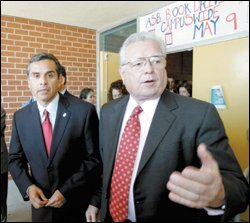Antonio Villaraigosa was elected mayor of Los Angeles last week, besting incumbent James K. Hahn in a race that often saw the two Democrats competing over who could better promote improvement in the city’s schools.
Mr. Villaraigosa, a City Council member, took 59 percent of the vote in the May 17 runoff election, which saw him matched once again with Mr. Hahn, who beat him to the mayor’s office in 2001. This time around, Mr. Hahn lost big, garnering 41 percent of the vote.
The candidates began devoting more attention to education in mid-March, shortly after a March 8 election gave no candidate the majority, and set Mr. Hahn and Mr. Villaraigosa up for a runoff.
The city charter gives the mayor no direct control over the 720,000-student Los Angeles Unified School District, but the Los Angeles Times had urged the next city leader to “be a visionary advocate, willing to press for radical change and engage a cynical populace on behalf of the struggling school system.”

Within a few weeks, both contenders had expressed support for a small-schools approach to raising achievement in the sprawling district, and had begun calling for a stronger mayoral role in education.
Mr. Hahn proposed that the mayor be allowed to appoint at least three additional members to the school board, whose seven members are now elected. Mr. Villaraigosa called for giving the mayor “ultimate control and oversight” of schools, but provided no specifics. The district serves 26 additional cities, however, complicating questions of control by the mayor of Los Angeles.
John Perez, the president of the 41,000-member United Teachers Los Angeles, for which Mr. Villaraigosa once worked as an organizer, said his election puts “a true friend of education in the mayor’s office.”
The union endorsed Mr. Villaraigosa, but opposes mayoral control of the schools. Mr. Perez predicted that the new mayor, who takes office July 1, would find there is insufficient consensus backing that approach and would concentrate instead on matters such as boosting state funding for the district’s schools.
The City Council and the school board are forming a joint, 30-member panel that will begin work next month examining the governance of the district.
Trouble at School
While Mr. Hahn now can be known as the first Los Angeles mayor to be voted out of office in three decades, Mr. Villaraigosa, 52, becomes the first Latino in more than a century to lead Los Angeles, where nearly half the nearly 4 million residents are of Hispanic origin.
He pledged during his campaign to work for smaller class sizes, more parental involvement in schools, and expanded preschool programs. He criticized Mr. Hahn for doing too little for schools as mayor.
On May 18, the mayor-elect planned to appear at Taft High School with district Superintendent Roy Romer and Jose Huizar, the president of the school board, in a visit that was intended to focus on working together, according to the Times.
But a fight among 9th graders on the campus sent frantic parents to the school, the newspaper reported. The three leaders instead spent their time discussing school safety and calming fears of racial tension between black and Hispanic students.
Marlene Canter, a school board member, said she thought it was time for the city to have a Latino mayor. But she does not favor giving the city’s mayor control over the school system.
“I do not believe it’s the mayor’s job to run the schools,” she said.





